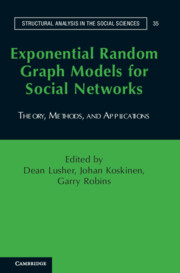Book contents
- Frontmatter
- Contents
- List of Figures
- List of Tables
- 1 Introduction
- Section I Rationale
- Section II Methods
- 6 Exponential Random Graph Model Fundamentals
- 7 Dependence Graphs and Sufficient Statistics
- 8 Social Selection, Dyadic Covariates, and Geospatial Effects
- 9 Autologistic Actor Attribute Models
- 10 Exponential Random Graph Model Extensions: Models for Multiple Networks and Bipartite Networks
- 11 Longitudinal Models
- 12 Simulation, Estimation, and Goodness of Fit
- 13 Illustrations: Simulation, Estimation, and Goodness of Fit
- Section III Applications
- Section IV Future
- References
- Index
- Name Index
10 - Exponential Random Graph Model Extensions: Models for Multiple Networks and Bipartite Networks
Published online by Cambridge University Press: 05 April 2013
- Frontmatter
- Contents
- List of Figures
- List of Tables
- 1 Introduction
- Section I Rationale
- Section II Methods
- 6 Exponential Random Graph Model Fundamentals
- 7 Dependence Graphs and Sufficient Statistics
- 8 Social Selection, Dyadic Covariates, and Geospatial Effects
- 9 Autologistic Actor Attribute Models
- 10 Exponential Random Graph Model Extensions: Models for Multiple Networks and Bipartite Networks
- 11 Longitudinal Models
- 12 Simulation, Estimation, and Goodness of Fit
- 13 Illustrations: Simulation, Estimation, and Goodness of Fit
- Section III Applications
- Section IV Future
- References
- Index
- Name Index
Summary
In previous chapters, we presented details of models for univariate one-mode network data. Exponential random graph models (ERGMs), however, can also be applied to other relational data types. In this chapter, we extend ERGM specifications to (1) multivariate analysis of two networks and (2) bipartite (or two-mode) networks. We discuss model specifications and possible parameter interpretations for both classes of models.
Multiple Networks
Social network analyses are not limited to one type of network, and it is often the case that more than one type of relational tie can be defined among a given set of nodes – for example, we can define both friendship and advice-giving ties among staff of an organization. When we have multiple network ties, we can then ask the research question about how different types of networks interact with each other, and how these interactions affect the structure of each network. For example, do friends seek advice from each other in the organization? We refer to the statistical analysis of multiple networks as “multivariate network analysis.”
Several techniques have been developed for the analysis of multiple networks, including blockmodels for multiple networks (White, Boorman, & Breiger, 1976), quadratic assignment procedures (Dekker, Krackhardt, & Snijders, 2007; Krackhardt, 1987), network algebraic models (Pattison, 1993), and ERGMs (Pattison & Wasserman, 1999). In this chapter, we focus on the simplest multivariate ERGM specifications for networks involving two types of ties defined on a common set of nodes.
- Type
- Chapter
- Information
- Exponential Random Graph Models for Social NetworksTheory, Methods, and Applications, pp. 115 - 129Publisher: Cambridge University PressPrint publication year: 2012
- 7
- Cited by



